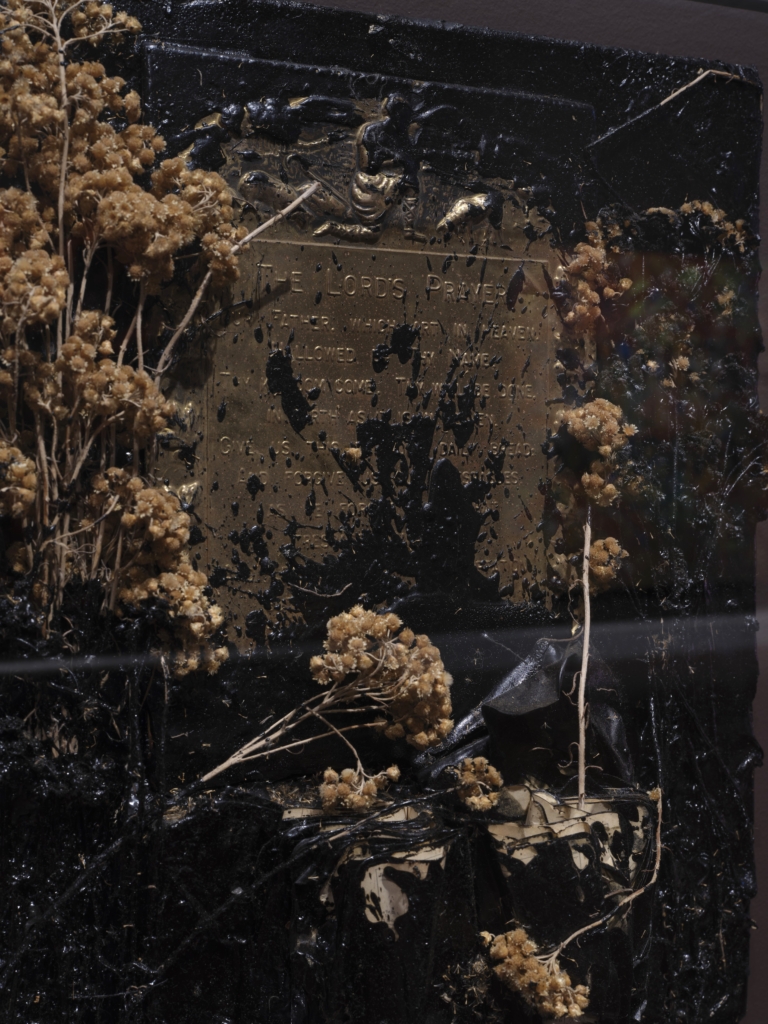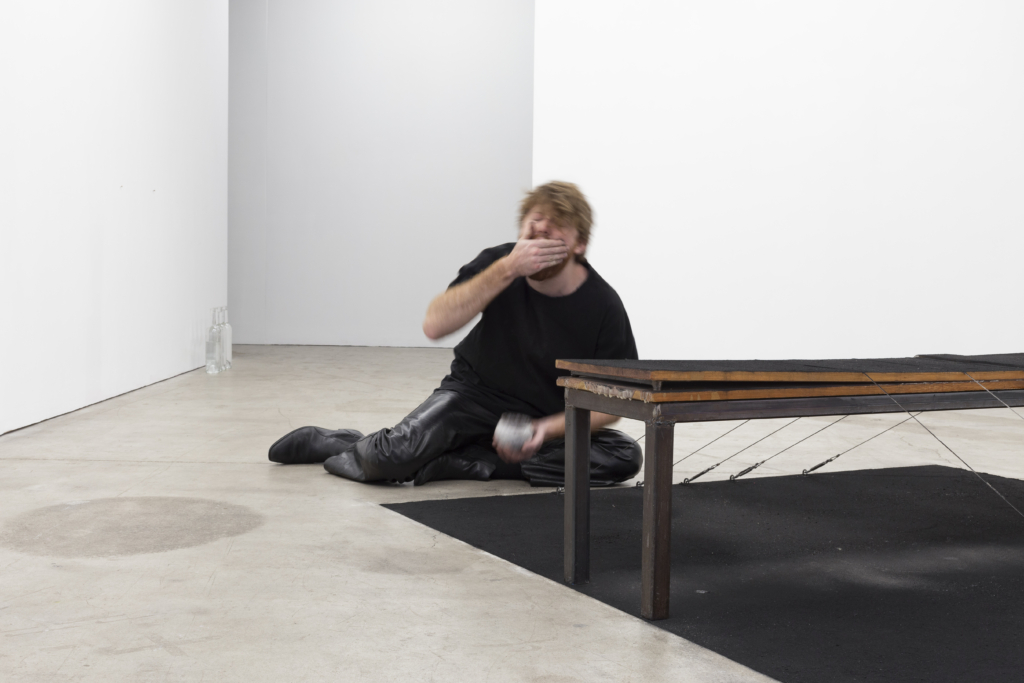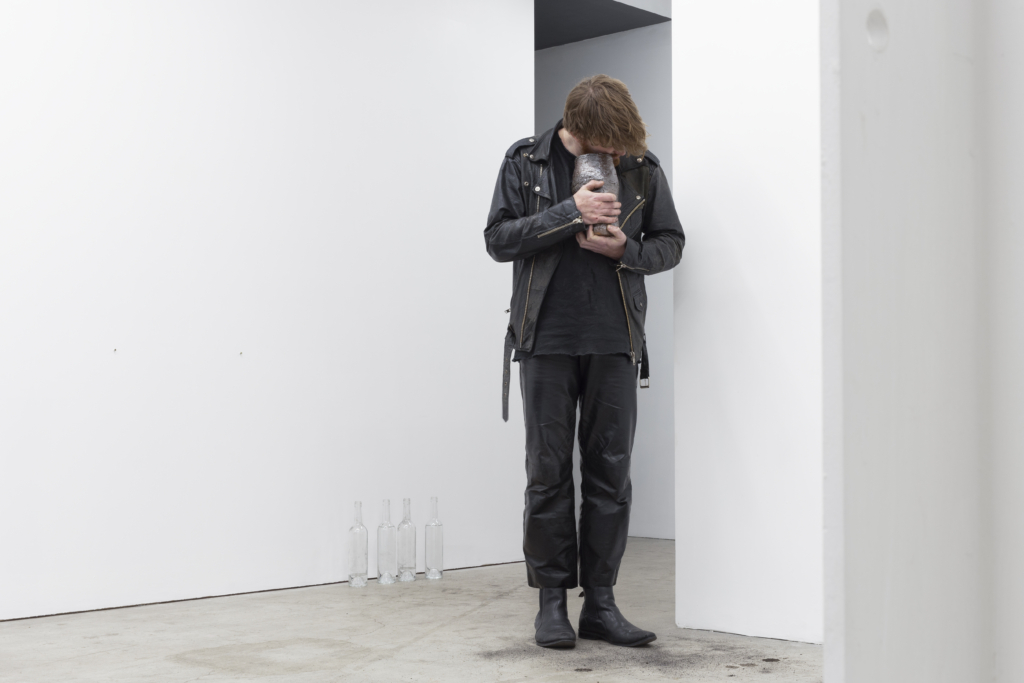Performance artist Tobias Allen sat down with City Gallery Wellington’s Public Programmes Specialist, Graham Frost to discuss How Far Do Your Arms Reach? his upcoming collaborative performance with Footnote New Zealand Dance, commissioned by City Gallery Wellington to mark the exhibition Derek Jarman: Delphinium Days.
Can you tell us about the inspiration behind How Far Do Your Arms Reach? what does it mean to be making, in conversation with Derek Jarman’s legacy?
The broader inspiration is, for me, a reflection on history, on gay history, and queer art history. Specifically, within this, the sensation that I feel when looking to this past in relation to a loneliness within the present.
The origin of this project also relates to this being the first time Derek Jarman’s work has been shown in Aotearoa, that it has closed the physical distance between where it was made to us in New Zealand. As well, Jarman’s significance in queer art history, a point of brightness in the darkness of the past, like Blue being the colour of the light that illuminates our past.
He’s one of these figures also, that we end up forming understandings of ourselves from, but that are not from where we are from – that kind of distance is always present in queer art history and it’s also very much present in an Aotearoa context.
So, in this way—as queer people and as a gay person and a gay man in New Zealand—we construct a vision or understanding of ourselves through things that we locate in the past, and we’re having to look around and behind ourselves into the darkness and attempt to stretch out our arms to find pockets of light to hold onto a sense of understanding.
And so, the piece is thinking through that sensation and the loneliness in being gay, its personal isolations, and then the loneliness within your position to a visible art history, which has always occurred at a distance – where you are piecing together or gathering fragments out of the dark in order to finds ways to expand, or to think of the larger whole.
I see the practice of making art as a gay man as the teasing out of fragments, drawing together or accumulating, then recontextualizing them. Like consuming them, eating them and absorbing them into a mass, back into myself, to vomit out another fragment that perhaps at some point in time, someone might be able to connect with or understand.
What you’re saying reminds me a little of Jarman’s tar paintings.
I loved the piece with actual flowers from Dungeness that were partially covered and partially not, next to the crucifix that was completely and utterly covered. The flowers are not only preserved by the material, but they protrude from it and then are also absorbed back into its darkness. They sit in-between.
The tar is such a consuming material. It’s smothering, it completely and utterly – not flattens, but – holds within itself all the objects underneath and between the substrate. It consumes the materials underneath, which become enmeshed within it, and so you’re left with the impressions of their silhouettes. Their sensational and erotic silhouettes that are within and without at the same time.

One of the most striking things about them as well, is when you think of history as an ever-expanding, enveloping blackness that we find impressions, sensations and textures within, those flowers are incredibly emotive and have such a deep relationship to Jarman and his sense of place and the sense of being which he cultivated. He cultivated the flowers, and he has cultivated his position in art history, to then smother and reabsorb both back into the darkness.
In your piece Ashes and Action, which you performed as part of the group exhibition To The Friend Who Did Not Save My Life, held at Enjoy Gallery last year, you attempted to consume four kilograms of ash over the course of several hours. Tell me about your relationship between these two forces, ashes and action.
I think with my material, I never want anything to be disappeared, I never want a material to be a stand in for something or a symbol for something else. The material should have an immediate embodiment of itself. I try to avoid materials as empty signals or pure surface signifiers, but things that can be, that are.
I mean, I guess that’s slightly misdirected because I didn’t actually eat human remains during the performance of eating ash. I made an ash to consume, to find somewhere to place that desire. The ash wasn’t necessarily a stand in for the human remains, but they were a way in which to appropriately place the desire to consume human remains, within the context of that action. The repeated gesture of that action was still one of eating.

In other words, the ash is not a metaphor for human remains, or as symbol for them. The ash is ash – it was made by heating through a material, in this case Manuka and Lavender, to the point that its borders disintegrate, its make-up is altered and falls apart or is reduced to carbon and each granule holds the wholeness of its old form in fragment. This process is the same thing that happens in cremation.
Oftentimes my material is mostly just my body and my flesh. I’m not interested in embodying a character or something else, a sort of theatrical performance. It’s not a Brechtian thing. It’s focusing on my body and a moment in time, the gestures that I’m able to do and doing within that. It’s an embodiment of an emotive experience – my body is not being dressed up or disappeared. I don’t want to be hiding one thing behind another, in order to ‘create’ meaning.

Tell me about action.
Action is something that happens, or is happening, and so that something has action, it is in movement. The word action conjures, more directly, and more clearly indicates what I’m interested in doing. Whereas performance, sometimes is out-of-time, you know, a stage play has its own kind of time.
Performance, again—always has a degree of separation within it. Someone is ‘performing’ and so it calls into question these social ideas of experiences of separation and distancing. That the person underneath the performance is being disappeared, and you’re supposed to not consider that.
I’ve been thinking about Grotowski’s Poor Theatre as well. Trying to—not democratize—but demarcate the barrier between audience and performer, where their presence within the work will affect and change it. Some people are more comfortable than others with breaking that barrier between performer and audience, some people are interested and wanting to engage, and others want to purely look, so it’s about keeping a sense of openness for the audience to become implicated while not forcing them into it.
Finding ways to softly break that apart at the same time, just purely through how the action set up. In ‘How Far Do Your Arms Reach?’, I try to do this through a decentralising of the action, it cannot ever be viewed as a single whole, through the nature of you having to wander around the gallery in order to see the parts of the work – to capture these fragments in darkness and build up the impression of the whole.
Your voice was such a powerful element of your piece Mourn You in The Seen, which you performed at City Gallery in 2022 as a response to the exhibition Tilia by Hendrix Hennessy-Ropiha and Dayle Palfreyman.
Thank you. I’m glad that it was powerful to you, and that it captured that. Again, I was trying to softly engage the audience, sometimes without them knowing. In that work, the feedback that’s there – the sound waves are affected by air pressure and people’s bodies and bodily heat as they move. People shift the surfaces of where those sounds are, so their physical presence is what creates a variation in tones and sounds that are able to be drawn out from that gesture.
The vocal performances are, sort of, a process of the voice being cremated through heat and of keeping this transformative thing going, that then disintegrates and granulates from the cohesive, identical whole of the body to pieces, where each single piece contains an entirety of the body and the voice.

I always think about – maybe it’s the complete opposite of Music, of Muzak, you know—but where sound is impartial, purely a constructed space that vanishes, is meant to disappear – this vanishing of the material – to do the opposite of this. It’s trying to do the opposite of making something that disappears, but sound that is so physical and unfurling that it cannot be disappeared; to focus directly on that physical presence in that moment in time.
Are there sonic or musical influences you’ve been thinking about with this new work?
Musically, there’s a range of things. Sara Davachi is a big one for me, in relation to this piece. She really focuses on timbre and texture, her compositions build themselves and as they slowly fall apart. She’s just released a new album called The Head As Form’d In The Crier’s Choir. It’s absolutely spectacular.
I’m thinking about a lot of minimal composition, of performance and musical history, but minimal music that’s not purely about the academics, but focusing on a timbre and a texture that builds up through time. Our piece might not have any resemblance to it, but I think conceptually, of Terry Riley’s In C and his modular compositions that can speak to each other, yet be entirely whole within themselves as well. They build up and disintegrate as the many performers relate to them.
I was in Berlin a couple of weeks ago and saw this piece by Argentinian noise/sculptural duo Lolo and Sosaku. The work was a series of mechanical objects that rotated, crashed, were smaller systems that made noises, textures, that were microphoned up – the sound built up from these systems and it was phenomenal. At one point, Lolo was actually welding pieces of metal connected to contact mics. So, you know, the sound itself was being generated by a closeness to the materiality.
For me in general, I’m always interested in making sure the way in which the sound is generated and accumulates and builds up is through processes that reflect the work itself, that I’m not just taking necessarily a nice sound from anywhere. And of course, I’m always coming back to the body; the sound of the breath. The conceptual onus of the work is that the methods in which the sound is generated reflect the things that I’m thinking about with the larger ‘artwork’.
How has your experience been collaborating with Footnote New Zealand Dance?
I didn’t really want to just put something together, choreograph a set of gestures and then make someone else do that – that didn’t feel particularly satisfying or necessarily interesting. It might’ve been aesthetically satisfying or gratifying, but it didn’t feel like anything I’d potentially learn from.
For me this is an ongoing attempt to understand the existential void, of being, of possessing a body. And, you know, understanding never as a fixed point but as something that one proceeds through. To confront loneliness and, where art in history are fragments you connect to, find an active mode of this in the present – to not be overwhelmed. This is, in part, why it’s been important to fold in parts close to home, from Douglas Wright, to images or sensations from Paul Johns. To resist loneliness and disconnect.
Dance and performance share so much in common. In some ways they almost sit parallel to each other, where the primary medium is the body. It’s a moment in time that’s a focus on emotive meaning through gesture and actions. There are so many similarities, yet always something fundamentally different. That kind of closeness is really interesting. There are so many shared ways of thinking between myself and Footnote and the dancers that I get to work with, but also so many differences.
And it’s been interesting as well – to develop an understanding of performance art history, you do have to look at dance, and it starts being spoken about through people like Merce Cunningham or Pina Bausch. You know, these moments where dance brushes up against performance art and they often crossed over.
The collaborative process so far has been a really interesting back and forth conversation of, for me, attempting to become familiar with and less terrified of the ways of thinking of dance—something that I’m not necessarily skilled in—but have an understanding of parts of its history, and then on the other side for them, of stepping over the side into my way of thinking and a ‘Performance Art’ way of thinking.
It’s really nice to step over into that, with an incredibly skilled and empathetic group of people as well. It’s been really special. They have a deep amount of skill and understanding about their world and what they do and their position in producing within that, and with an incredible history behind them. They do it empathetically, openly, and approach me and be as interested in learning from the experience as I am.
Tobias Allen
Tobias Allen (He/Him) is a New Zealand contemporary artist based in Glasgow, Scotland. Having completed his BFA (Hons) from Massey University in 2021, Allen is now pursuing an MFA at The Glasgow School of Art.
Working in performance, video and sound, his work examines the broad and difficult relationships between grief, death, and queerness, with a focus on the deep-seated emotional states to be encountered therein.
Recent works include Ashes and Action and To The Friend Who Did Not Save MY Life ENJOY Gallery (2023), My Skin in Open // RED RAW (2023); Mourn You in the Seen, City Gallery Wellington Te Whare Toi (2022); The Car Video (Tenofovir Blue) (2022); and The Corpse, the Voice, the Faggot and We, Performance Art Week, Wellington (2021).
Derek Jarman: Delphinium Days has been co-developed by Gus Fisher Gallery and City Gallery Wellington Te Whare Toi. It is co-curated by Lisa Beauchamp, Curator of Contemporary Art at Gus Fisher Gallery, Aaron Lister, Senior Curator (Toi) at City Gallery Wellington Te Whare Toi, and Michael Lett.
How Far Do Your Arms Reach? is part of the expanded public programme staged across Wellington city and at The Dowse Art Museum, supported by the British Council New Zealand and the Pacific.
Tickets for the performance are available now.
IMAGES
Derek Jarman, The Lord’s Prayer, 1989. (detail) Private collection. Photography by Sam Hartnett.
Image courtesy of Gus Fisher, Auckland.
Tobias Allen, Ashes and Action, 2023. Enjoy Gallery. Photography by Cheska Brown. Image courtesy of the artist.
Tobias Allen, Ashes and Action, 2023. Enjoy Gallery. Photography by Cheska Brown. Image courtesy of the artist.
Tobias Allen, Mourn You in the Seen, 2022. City Gallery Wellington. Photography by Sara Tansey. Image courtesy of the artist.


